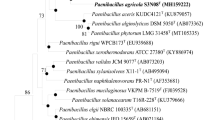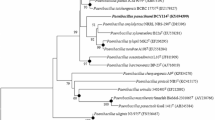Abstract
Strain DCY84T, a Gram-stain positive, rod-shaped, aerobic, spore-forming bacterium, motile by means of peritrichous flagella, was isolated from humus soil from Yongin forest in Gyeonggi province, South Korea. Strain DCY84T shared the highest sequence similarity with Paenibacillus barengoltzii KACC 15270T (96.86 %), followed by Paenibacillus timonensis KACC 11491T (96.49 %) and Paenibacillus phoenicis NBRC 106274T (95.77 %). Strain DCY84T was found to able to grow best in TSA at temperature 30 °C, at pH 8 and at 0.5 % NaCl. MK-7 menaquinone was identified as the isoprenoid quinone. The major polar lipids were identified as phosphatidylethanolamine, an unidentified aminophospholipid, two unidentified aminolipids and an unidentified polar lipid. The peptidoglycan was found to contain the amino acids meso-diaminopimelic acid, alanine and d-glutamic acid. The major fatty acids of strain DCY84T were identified as branched chain anteiso-C15:0, saturated C16:0 and branched chain anteiso-C17:0. The cell wall sugars of strain DCY84T were found to comprise of ribose, galactose and xylose. The major polyamine was identified as spermidine. The DNA G+C content was determined to be 62.6 mol%. After 6 days of incubation, strain DCY84T produced 52.96 ± 1.85 and 72.83 ± 2.86 µg/ml l-indole-3-acetic acid, using media without l-tryptophan and supplemented with l-tryptophan, respectively. Strain DCY84T was also found to be able to solubilize phosphate and produce siderophores. On the basis of the phenotypic characteristics, genotypic analysis and chemotaxonomic characteristics, strain DCY84T is considered to represent a novel species of the genus Paenibacillus, for which the name Paenibacillus yonginensis sp. nov. is proposed. The type strain is DCY84T (=KCTC 33428T = JCM 19885T).


Similar content being viewed by others
References
Ash C, Farrow JAE, Wallbanks S, Collins MD (1991) Phylogenetic heterogeneity of the genus Bacillus as revealed by comparative analysis of small-subunit-ribosomal RNA sequences. Lett Appl Microbiol 13:202–206
Bauer AW, Kirby WMM, Sherris JC, Turck M (1966) Antibiotic susceptibility testing by a standardized single disk method. Am J Clin Pathol 45:493–496
Benardini JN, Vaishampayan PA, Schwendner P, Swanner E, Fukui Y, Osman S, Satomi M, Venkateswaran K (2011) Paenibacillus phoenicis sp. nov., isolated from the Phoenix Lander assembly facility and a subsurface molybdenum mine. Int J Syst Evol Microbiol 61:1338–1343
Beneduzi A, Costa PB, Parma M, Melo IS, Bodanese-Zanettini MH, Passaglia LM (2010) Paenibacillus riograndensis sp. nov., a nitrogen-fixing species isolated from the rhizosphere of Triticum aestivum. Int J Syst Evol Microbiol 60:128–133
Carro L, Flores-Félix JD, Cerda-Castillo E, Ramírez-Bahena MH, Igual JM, Tejedor C, Velázquez E, Peix A (2013) Paenibacillus endophyticus sp. nov., isolated from nodules of Cicer arietinum. Int J Syst Evol Microbiol 63:4433–4438
Collins MD (1985) Isoprenoid quinone analyses in bacterial classification and identification. In: Goodfellow M, Minnikin DE (eds) Chemical methods in bacterial systematics. Academic Press, London, pp 267–287
Cowan ST, Steel KJ (1974) Manual for the identification of medical bacteria, 3rd edn. Cambridge University Press, Cambridge
Dsouza M, Taylor MW, Ryan J, MacKenzie A, Lagutin K, Anderson RF, Turner SJ, Aislabie J (2014) Paenibacillus darwinianus sp. nov., isolated from gamma-irradiated Antarctic soil. Int J Syst Evol Microbiol 64:1406–1411
Felsenstein J (1981) Evolutionary trees from DNA sequences: a maximum likelihood approach. J Mol Evol 17:368–376
Felsenstein J (1985) Confidence limits on phylogenies: an approach using the bootstrap. Evolution 39:783–791
Fitch WM (1971) Toward defining the course of evolution: minimum change for a specific tree topology. Syst Zool 20:406–416
Glickmann E, Dessaux Y (1995) A critical examination of the specificity of the Salkowski reagent for indolic compounds produced by phytopathogenic bacteria. Appl Environ Microbiol 61:793–796
Gomori G (1955) Preparation of buffers for use in enzyme studies. In: Colowick SP, Kaplan NO (eds) Methods in enzymology. Academic Press, New York, pp 138–146
Hall TA (1999) BioEdit: a user-friendly biological sequence alignment editor and analysis program for Windows 95/98/NT. Nucleic Acids Symp Ser 41:95–98
Hayat R, Ali S, Amara U, Khalid R, Ahmed I (2010) Soil beneficial bacteria and their role in plant growth promotion: a review. Ann Microbiol 60:579–598
Johnson M, Zaretskaya I, Raytselis Y, Merezhuk Y, McGinnis S, Madden TL (2008) NCBI BLAST: a better web interface. Nucleic Acids Res 1:36 (Web Server issue):W5-9. doi: 10.1093/nar/gkn201
Kim MK, Im WT, Ohta H, Lee M, Lee ST (2005) Sphingopyxisgranuli sp. nov., a ß-glucosidase-producing bacterium in the family Sphingomonadaceae in α-4 subclass of the Proteobacteria. J Microbiol 43:152–157
Kim OS, Cho YJ, Lee K, Yoon SH, Kim M, Na H, Park SC, Jeon YS, Lee JH, Yi H, Won S, Chun J (2012) Introducing EzTaxon-e: a prokaryotic 16S rRNA Gene sequence database with phylotypes that represent uncultured species. Int J Syst Evol Microbiol 62:716–721
Kimura M (1983) The neutral theory of molecular evolution. Cambridge University Press, Cambridge
Lane DJ (1991) 16S/23S rRNA sequencing. In: Stackebrandt E, Goodfellow M (eds) Nucleic acid techniques in bacterial systematics. Wiley, Chichester, pp 115–176
Logan NA, Berge O, Bishop AH, Busse HJ, De Vos P, Fritze D, Heyndrickx M, Kämpfer P, Rabinovitch L, Salkinoja-Salonen MS, Seldin L, Ventosa A (2009) Proposed minimal standards for describing new taxa of aerobic, endospore-forming bacteria. Int J Syst Evol Microbiol 59:2114–2121
Mesbah M, Premachandran U, Whitman WB (1989) Precise measurement of the G+C content of deoxyribonucleic acid by high performance liquid chromatography. Int J Syst Bacteriol 39:159–167
Minnikin DE, ODonnell AG, Goodfellow M, Alderson G, Athalye M, Schaal A, Parlett JH (1984) An integrated procedure for the extraction of bacterial isoprenoid quinones and polar lipids. J Microbiol Methods 2:233–241
Montes MJ, Mercade E, Bozal N, Guinea J (2004) Paenibacillus antarcticus sp. nov., a novel psychrotolerant organism from the Antarctic environment. Int J Syst Evol Microbiol 54:1521–1526
Osman S, Satomi M, Venkateswaran K (2006) Paenibacillus pasadenensis sp. nov. and Paenibacillus barengoltzii sp. nov., isolated from a spacecraft assembly facility. Int J Syst Evol Microbiol 56:1509–1514
Park MJ, Kim HB, An DS, Yang HC, Oh ST, Chung HJ, Yang DC (2007) Paenibacillus soli sp. nov., a xylanolytic bacterium isolated from soil. Int J Syst Evol Microbiol 57:146–150
Park DS, Jeong WJ, Lee KH, Oh HW, Kim BC, Bae KS, Park HY (2009) Paenibacillus pectinilyticus sp. nov., isolated from the gut of Diestrammena apicalis. Int J Syst Evol Microbiol 59:1342–1347
Pikovskaya RI (1948) Mobilization of phosphorus in soil in connection with vital activity of some microbial species. Mikrobiologya 17:362–370
Priest FG (2009) Genus I. Paenibacillus. In: DeVos P, Garrity G, Jones D, Krieg NR, Ludwig W, Rainey FA, Schleifer KH, Whitman WB (eds) Bergey’s manual of systematic bacteriology, vol 2, 2nd edn. Springer, New York, pp 269–296
Saha P, Mondal AK, Mayilraj S, Krishnamurthi S, Bhattacharya A, Chakrabarti T (2005) Paenibacillus assamensis sp. nov., a novel bacterium isolated from a warm spring in Assam, India. Int J Syst Evol Microbiol 55:2577–2581
Saitou N, Nei M (1987) The neighbor-joining method: a new method for reconstructing phylogenetic trees. Mol Biol Evol 4:406–425
Sánchez MM, Fritze D, Blanco A, Spröer C, Tindall BJ, Schumann P, Kroppenstedt RM, Diaz P, Pastor FI (2005) Paenibacillus barcinonensis sp. nov., a xylanase-producing bacterium isolated from a rice field in the Ebro River delta. Int J Syst Evol Microbiol 55:935–939
Sasser M (1990) Identification of bacteria by gas chromatography of cellular fatty acids, MIDI Technical Note 101. DE: MIDI Inc, Newark
Scherer PA, Kneifel H (1983) Distribution of polyamines in methanogenic bacteria. J Bacteriol 154:1315–1322
Schleifer KH (1985) Analysis of the chemical composition and primary structure of murein. Methods Microbiol 18:123–156
Schumann P (2011) Peptidoglycan structure. Methods Microbiol 38:101–129
Schwyn B, Neilands JB (1987) Universal chemical assay for the detection and determination of siderophores. Anal Biochem 160:47–56
Shida O, Takagi H, Kadowaki K, Nakamura LK, Komagata K (1997) Transfer of Bacillus alginolyticus, Bacillus chondroitinus, Bacillus curdlanolyticus, Bacillus glucanolyticus, Bacillus kobensis, and Bacillus thiaminolyticus to the genus Paenibacillus and emended description of the genus Paenibacillus. Int J Syst Bacteriol 47:289–298
Shokri D, Emtiazi G (2010) Indole-3-acetic acid (IAA) production in symbiotic and non-symbiotic nitrogen-fixing bacteria and its optimization by Taguchi design. Curr Microbiol 61:217–225
Skerman VBD (1967) A guide to the identification of the genera of bacteria, 2nd edn. Williams and Wilkins, Baltimore
Staneck JL, Roberts GD (1974) Simplified approach to identification of aerobic actinomycetes by thin-layer chromatography. Appl Microbiol 28:226–231
Taibi G, Schiavo MR, Gueli MC, Calanni Rindina P, Muratore R, Nicotra CMA (2000) Rapid and simultaneous high-performance liquid chromatography assay of polyamines and monoacetylpolyamines in biological specimens. J Chromatogr B 745:431–437
Tamura K, Stecher G, Peterson D, Filipski A, Kumar S (2013) MEGA6: molecular evolutionary genetics analysis version 6.0. Mol Biol Evol 30:2725–2729
Thompson JD, Gibson TJ, Plewniak F, Jeanmougin F, Higgins DG (1997) The CLUSTAL_X windows interface: flexible strategies for multiple sequence alignment aided by quality analysis tools. Nucleic Acids Res 25:4876–4882
Valverde A, Peix A, Rivas R, Velázquez E, Salazar S, Santa-Regina I, Rodríguez-Barrueco C, Igual JM (2008) Paenibacillus castaneae sp. nov., isolated from the phyllosphere of Castanea sativa Miller. Int J Syst Evol Microbiol 58:2560–2564
Vaz-Moreira I, Faria C, Nobre MF, Schumann P, Nunes OC, Manaia CM (2007) Paenibacillus humicus sp. nov., isolated from poultry litter compost. Int J Syst Evol Microbiol 57:2267–2271
Verma N, Singh NA, Kumar N, Raghu HV (2013) Screening of different media for sporulation of Bacillus megaterium. Int J Micro Res Rev 1(4):068–073
Wang L, Baek SH, Cui Y, Lee HG, Lee ST (2012) Paenibacillus sediminis sp. nov., a xylanolytic bacterium isolated from a tidal flat. Int J Syst Evol Microbiol 62:1284–1288
Weisburg WG, Barns SM, Pelletier DA, Lane DJ (1991) 16S ribosomal DNA amplification for phylogenetic study. J Bacteriol 173:697–703
Weller DM (2007) Pseudomonas biocontrol agents of soilborne pathogens: looking back over 30 years. Phytopathology 97:250–256
Yoon JH, Kang SJ, Yeo SH, Oh TK (2005) Paenibacillus alkaliterrae sp. nov., isolated from an alkaline soil in Korea. Int J Syst Evol Microbiol 55:2339–2344
Acknowledgments
This research was supported by Korea Institute of Planning & Evaluation for Technology in Food, Agriculture, Forestry & Fisheries (KIPET NO: 309019-03-3-SB010) and Next-Generation BioGreen 21 Program (SSAC, grant#: PJ009529032014), Republic of Korea.
Author information
Authors and Affiliations
Corresponding authors
Electronic supplementary material
Below is the link to the electronic supplementary material.
10482_2014_263_MOESM1_ESM.tif
The maximum likelihood tree based on 16S rRNA gene sequence analysis showing phylogenetic relationships of strain DCY84T and members of the genus Paenibacillus. Supplementary material 1 (TIFF 12396 kb)
10482_2014_263_MOESM2_ESM.tif
Transmission electron micrograph of Paenibacillus yonginensis DCY84T. Bar indicated 1.0 μm. Supplementary material 2 (TIFF 2889 kb)
10482_2014_263_MOESM3_ESM.tif
Plant growth promoting activity test: a Clear halo regions observed around the colonies on opaque Pikovskaya medium indicate the positive result for the phosphate solubilization test. b Siderophore production test using Pseudomonas Agar F medium (Difco) supplemented with a chrome azurol S complex [CAS/iron(III)/hexadeciltrimethyl ammonium bromide]. The yellow halo zones on blue-green colour medium indicates apositive result for siderophores production by strain DCY84T. Supplementary material 3 (TIFF 5984 kb)
Rights and permissions
About this article
Cite this article
Sukweenadhi, J., Kim, YJ., Lee, K.J. et al. Paenibacillus yonginensis sp. nov., a potential plant growth promoting bacterium isolated from humus soil of Yongin forest. Antonie van Leeuwenhoek 106, 935–945 (2014). https://doi.org/10.1007/s10482-014-0263-8
Received:
Accepted:
Published:
Issue Date:
DOI: https://doi.org/10.1007/s10482-014-0263-8




